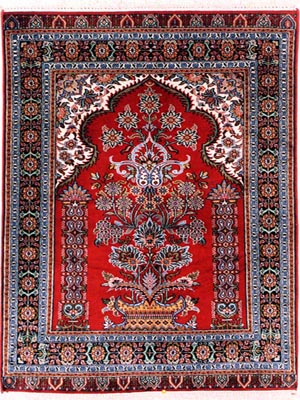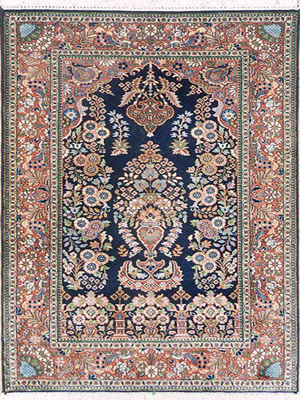|
Carpets A hand knotted
carpet of
Kashmir is perhaps the most coveted craft of textile weavers, a passionately ornate work of art.
Carpet
weaving was introduced in Kashmir from Persia and Asia . Hand Knotted carpet from Kashmir is a
result of
hundred years of research and practice which makes it a prized item in the international trade.
Having its
origin in the nomadic life, it is as old as the civilization itself. The nomads handed it over to
the
civilization of settled population. The Muslim saint Zanul � Abudin 650, found the earliest evidence
of the
hand knotted carpet years ago from the deserts of Iran . The rug discovered belonged to 5 th century
B.C.
having 360,000 knots per square meter (232 knots per square inch ). During the reign of Moghuls some
immigration of carpet weavers took place from Persia to India and thus the Persian designs were
mixed with the
local styles to produce some of the greatest carpets in the history. Carpets depicting Moghul
hunting were
very much famous all over the world. Some of these splendid products are still preserved in museums.
Today
Oriental carpets are manufactured all over the Asian Continent; from Balkans to China and Caucasus
to Indo-Pak
sub-continent.
Carpets from Kashmir enjoy a special place of
pride among
Indian handicrafts. A fine example of excellent workmanship, these carpets form an integral part
of Kashmir
's rich cultural heritage. Intricately designed, with attractive colour schemes, they are an
artistic
expression of the weavers imagination. While the music of the beautiful surroundings echo
through each knot,
the richness of the pastures is embedded into the surface itself. The designs and patterns in
Kashmiri
Carpets continued to be inspired by Persian and Central Asian rugs, though the influence of
Indo- Asian art
is noticeable. Besides the widely famed designs like Kashan, Kirman, Ardebil , Bukhara , Ghoum,
Tabriz ,
Isfan, Nain, Khurosan, Djozan, Heriz, Joshrang, etc�peculiarly Kashmiri variants depicting
valley's scenic
splendour as well as some based on shawl patterns have also been evolved. Kashmiri craftsmen
have the
remarkable ability to reproduce even the most intricate designs. It is said that Kashmiri
Carpets once so
charmed Maharaja Ranjit Singh that he rolled on it in great joy. An interesting feature of
carpet weaving in
Kashmir is that the design is guided by the talim, a coded script committed to paper indicating
the number
of knots to be piled in a square inch as also the colour scheme along with lines in wool or silk
or both (
the warp is invariably in cotton ). The talim is fixed into the warp threads for execution. A
colour chart,
locally called �Ranga Ticket� containing actual dyed pieces of yarn is also used for reference.
The talim
writer employs different symbols for various colours and shades the process being extremely
intricate
requiring considerable calculation & concentration. To encode a design for an average carpet
takes over
three months. Abstract symbols could be woven into dense ornamentation. The geometric designs
can be
combined with figures and florals with different meanings. Endless experimentation led to the
perfection of
natural dyes. Plants, flowers, vegetables, fruits and even insects were a source of colours.
Sour cream was
used to tone down colours. The useof colours were a part of individual skills, the nature of
various dyes
often being a jealously guarded secret. The quality and therefore the prices of a carpet is
determined by
the number of knots to a square inch and fineness of the material used. Quality of dying and
finishing are
also important determents.
THE BEAUTY OF ORIENTAL CARPETS can be
approached
not only in terms of art and mathematics, but also within the contexts of Islamic art and
spirituality.
Historically, throughout the Islamic world from Spain to Indonesia , patterns appear in architecture
and
interiors to organize space and to beautify the built environment. All patterns reflect the pure
beauty of
numbers, considered to be of divine origin in Islamic doctrine. And by their very nature, patterns
exhibit
multiplicity as expressions of unity, which is an attribute of God. Patterns in Oriental carpets may
thus be
seen as expressive of a world view in which multiplicity exists in relation to the unity of all
existence.
|
|
 
|
ORIENTAL CARPETS
have long been appreciated for their beauty. That beauty is achieved through the
choice of colors
and designs, as well as by the manipulation of designs and colors to form
pleasing patterns.
Patterns in Oriental carpets are never quite what you
expect - a
surprise here, a flourish there, a change of color, the flip or rotation of a design
where you might
not predict it. The more you look, the more variations you will find. How can we
explain this
phenomenon? Is it the result of human choice, or human error? The study of symmetry
offers one
approach to analyzing patterns in Oriental carpets. Through symmetry analysis we may
identify areas of
pattern that exhibit expected repetitions, and areas that vary from that
expectation.
|
|
THE BEAUTY OF
CARPETS also depends upon the quality of yarns that go into their
construction. The warp
consists of a set of parallel yarns held taut on a loom. The weft is composed of
cross-wise yarns that
interlace with the length-wise warp yarns as weaving progresses. The pile is formed
by rows of what
are called knots projecting from the foundation of interlacing warp and weft. Each
knot is formed by
inserting a supplementary yarn and wrapping it around a pair of warps. After
weaving, the pile is cut
to a uniform height.
Only the pile yarns are visible on the surface of a carpet.
It is the pile
that carries the colors, designs, and patterns. Thus, Oriental carpets are
two-dimensional in the
appearance of surface design; they are, however, three-dimensional in structure. The
type of knot used
in the construction of a carpet is one of several technical characteristics which, when
considered with
style, provides a means of grouping Oriental rugs. Comparing rugs with similar technical
and stylistic
features may help in figuring out where they may have come from and who wove them.
ORIENTAL CARPETS come from
traditional
rug-weaving areas of the world: Turkey , the Caucasus, Iran , Central Asia, western
China , and India .
In the 15th and 16th centuries, they were also produced in Spain and Egypt . Over the
centuries,
rug-producing regions developed distinctive styles based upon local traditions of
manufacture,
availability of materials and dyestuffs, and preferences for particular patterns,
designs, and colors.
Rugs from different areas share technical and stylistic features that enable us to
identify major
regional groupings as shown.
|
|
Points to keep in mind when choosing a carpet
:
* Whether it has been made of silk pile on silk base, silk
pile on cotton
base, silk and wool on cotton base or wool on cotton base. * The number of knots on the
reverse of the
carpet; whether one or more line in the design has been omitted completely in which case
the pattern
looks lopsided; * Whether any element in the design has been wrongly woven so that one
motif is larger
or smaller at one end than the corresponding motif at another end, etc. * Whether each
motif or element
of design has clear, crisp outlines; blurred edges indicate a fault in the weaving. *
Whether the edges
of the carpet are crooked as if it had been incorrectly mounted on the frame, so that
one end is broader
than another.
|
|
|